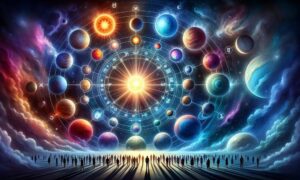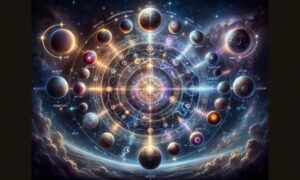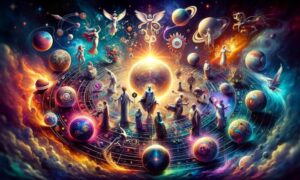Astrology is an ancient practice that examines the positions and movements of celestial bodies to gain insight into events on earth. Central to astrology are the roles and influences of the planets, which have fascinated humans since ancient times. In astrology, planets represent different energies and principles that shape our lives. By studying the planets in the natal chart, astrologers can reveal information about a person’s personality, relationships, and destiny. Let’s explore the symbolism and significance of the planets in astrology.
Understanding Planetary Influences
The planets exert influence in astrology based on their positions in the zodiac and in relation to other celestial bodies. Each planet rules over certain signs and houses, imbuing those areas of life with its unique energy. For instance, passionate Mars rules Aries, whereas communicative Mercury rules Gemini. When a planet occupies or aspects a particular house, it activates that sphere of life. Saturn in the 10th house promotes career advancement but can also indicate delays. Planets also form angular relationships with each other known as aspects, creating planetary patterns that shape events and character. Hard aspects like squares tend to stimulate challenges and growth, while soft aspects like trines provide support.
The Sun
The Sun represents one’s core sense of self, creative force, and life purpose. It governs leadership, legacy, and authority. In the natal chart, the Sun signifies the role of the father and the experiences that build self-confidence. The Sun’s house placement indicates where one can best express their identity. For example, Sun in the 5th house suggests a natural flair for creative self-expression.
The Moon
The Moon represents emotions, habits, the home, and the mother. It shapes our unconscious patterns, intuition, and responses. The Moon sign describes our emotional needs and style of relating. Moon in Cancer craves security while Moon in Aquarius needs intellectual stimulation. The Moon’s house and aspects reveal our emotional landscape and early childhood imprinting. Overall, the Moon reflects our inner world.
Exploring the Symbolism of Planets

Beyond their astrological meanings, the planets also encapsulate rich mythological significance. Their symbolic natures derive from ancient stories about the Roman gods they are named after. Jupiter, Saturn, Mars, Venus, and Mercury were revered deities with unique iconography and attributes that shaped their astrological identities. For instance, red planet Mars embodied the god of war, imbuing astrological Mars with fiery assertiveness. Blue planet Neptune was the god of the seas, linking it to imagination, spirituality, and transcendence in astrology. Understanding the mythic roots of the planets lends depth to interpreting their astrological meanings.
Jupiter
Jupiter’s mythology ties it to luck, abundance and wisdom. In astrology, expansive Jupiter promotes growth, optimism and prosperity. Jupiterian energy inspires us to broaden our horizons through travel, education, and new experiences. Jupiter’s placement indicates one’s philosophical outlook and generosity. As the traditional ruler of Pisces, Jupiter also governs spirituality and mysticism.
Saturn
Named after the Roman god of time and structure, Saturn represents restriction, hardship, and maturity. In astrology, stern Saturn promotes self-discipline, focus, and perseverance. Saturn governs our limitations but also our greatest achievements through hard work. Saturnian energy urges us to take responsibility and reflect on life’s lessons. Saturn’s placement and aspects test us but ultimately impart wisdom.
The Impact of Planets on Personality
The planets shape key traits of our personality and character. By blending the energies of our Sun, Moon, Mercury, Venus and Mars signs, the planets produce an intricate astrological blueprint of our individuality. For example, a Pisces Sun (imaginative, sensitive) combined with a Virgo Moon (practical, analytical) creates a dreamy yet grounded character. Beyond our inner planets, outer planets like Uranus and Pluto reveal generational traits and unconscious patterns. Studying how the planetary symbols manifest in your chart provides insight into your unique way of being.
Sun Sign
Our Sun sign represents the core of our personality – the ego, will, and sense of self. It epitomizes what motivates and inspires us. Sun in Leo types are outgoing and creative whereas Sun in Capricorn individuals are reserved and responsible. The Sun’s zodiac sign is the foundation of identity.
Moon Sign
Our Moon sign shapes our emotional nature, unconscious habits, and how we connect. Moon in Scorpio individuals are intense, while Moon in Libra people strive for balance and partnership. The Moon sign depicts our inner world, intuition, and deepest needs.
Rising Sign
The Ascendant or Rising sign colors how we express ourselves and engage with our environment. It describes our outer personality and how others perceive us initially. Leo rising natives possess bold, charismatic energy whereas Cancer rising types seem gentle and nurturing. Our Rising sign filters how our inner planets manifest outwardly.
Planets and their Astrological Significance

Beyond the personal planets, astrologers also examine the social and generational planets – Jupiter, Saturn, Uranus, Neptune and Pluto. These outer planets move slowly, shifting signs every 1-30 years, so they define the cultural and collective climate. The social planets and Saturn sculpt beliefs, opportunities, and challenges on a societal level. Meanwhile, generational planets Uranus, Neptune, and Pluto shape the evolution of entire generations through their alignment with historical cycles. Studying outer planet placements provides perspective on our karmic patterns and place in history.
Jupiter’s Expansiveness
Abundant Jupiter broadens horizons and inspires growth. In astrology, Jupiter represents wisdom, luck, travel, and philosophy. When in harmony, Jupiter illuminates multiple pathways to success. However, in excess, Jupiter can inflate ego, overindulgence, and unrealistic optimism. Jupiter teaches us when to stretch beyond our limits versus when restraint is prudent.
Saturn’s Discipline
Ringed planet Saturn represents adversity, limitations, and time. In astrology, Saturn is the taskmaster who demands patience, discipline, and responsibility. While sometimes bleak, Saturn imparts structure and wisdom. Saturn reminds us that rewards require effort. Its lessons temper the soul and lead to maturity.
Uranus’ Change
Radical Uranus drives progress, revelation, and revolution. In astrology, Uranus awakens us to new perspectives through its flash of brilliance. Uranus prompts invention, originality, and social change. However, Uranus can also disrupt and shock through its erratic energy. Uranus compels us to liberate ourselves from outdated modes of thinking.
Decoding Planetary Transits
In astrological transits, planets form major alignments with the planets or angles in the natal chart, sparking significant life events. For instance, Jupiter conjunct the Sun often signals happy news, while Saturn square the Moon can trigger emotional hardship. Each planet activates different natal chart points and houses during its transit, ushering propitious or challenging times. Tracking planetary transits illuminate periods of opportunity, growth, or crisis unfolding in our lives according to astrological symbolism.
Jupiter’s Opportunities
When expansive Jupiter transits trine or conjunction key points in our chart, we often experience fortuitous events, honors, expanded prosperity, or exciting travel. For example, Jupiter conjunct the Sun boosts confidence and success while trine the Moon lifts spirits. However, in hard aspect, Jupiter can inflate ego or overextension. Overall, Jupiter opens doors through its benevolent optimism.
Saturn’s Challenges
During significant Saturn transits, we face obstacles that require maturity and resilience. Saturn conjunct the Sun tests leadership skills while Saturn square Mars demands patience during conflict. Yet Saturn ultimately strengthens character and craft. For example, Saturn return at 29 ushers adulthood while Saturn trine the Midheaven bestows career advancement. We grow wiser through Saturn’s trials.
Planetary Aspects and their Meanings
Planetary aspects occur when planets form specific geometric angles to each other, creating powerful astrological energy dynamics. Aspects embed key themes into the natal chart through the interaction between planetary energies. Flowing aspects like trines and sextiles infuse talents and opportunities. Challenging aspects like squares and oppositions spur growth through tension. Understanding aspects between planets unlocks the natal chart’s intricate patterns.
Flowing Trine
A trine occurs when planets are 120 degrees apart, blending their energies harmoniously. For example, the Moon trine Venus indicates emotional and social harmony. Trines signify innate talents and come more easily than hard aspects. However, without effort, easy trines can lead to wasted potential.
Dynamic Square
The 90 degree square aspect stirs conflict and obstacles between planets. For instance, Mars square Saturn generates ambition but also frustration. Squares demand action and catalyze growth through struggle. Squares inject motivation to tackle issues that stimulate development. Resolving squares unlocks potential.
Energizing Sextile
The 60 degree sextile aspect infuses planets with cooperative energy, prompting opportune alliances. For example, Mercury sextile Uranus combines logic and originality. Sextiles provide a steady flow of support that needs to be activated to reach full potential.
Polarity of the Opposition
Oppositions occur when planets are directly opposite, 180 degrees apart. This aspect juxtaposes contradictory impulses. For instance, Jupiter opposite Saturn contrasts growth and restraint. Synthesizing opposing forces fosters balance, perspective and wholeness. Oppositions help us integrate dualities.
The Influence of Planets on Relationships
In synastry, chart comparison between partners, planetary aspects unveil relationship dynamics. Flowing aspects like Venus trine Mars indicate passion and affection. However, harsh aspects like Saturn square Venus can point to relationship tests. Analyzing how your planets interact with a partner’s horoscope reveals your chemistry, communication style, and mutual understanding. Planetary synastry illuminates how to navigate each pairing for success.
Venus’ Love and Harmony
Venus signifies love, beauty, and unity in relationships. Favorable Venus aspects in synastry promote affection, enjoyment, and compatibility. For example, Venus trine Mars ignites physical chemistry. However, hard Venus aspects signal disharmony and disputes. Venus reveals how to improve cooperation and intimacy.
Mars’ Drive and Passion
Fiery Mars governs desire, initiative, and action in relationships. Harmonious Mars aspects generate excitement and momentum. Mars trine Jupiter amplifies adventurous spirits, exploration, and optimism. But Mars square Pluto can indicate power struggles. Mars shows how partners can direct energy constructively.
Saturn’s Commitment
Serious Saturn represents longevity, maturity, and stability. In synastry, flowing Saturn aspects, like Saturn trine Moon, suggest devotion and emotional security. Yet challenging Saturn aspects reflect issues around control or insecurity. Saturn smoothes relationships by building trust.
Chiron’s Healing
Maverick Chiron governs healing wounds. In synastry, Chiron contacts point toward old hurts but also great compassion. Chiron trine Venus allows partners to rebuild self-esteem and create harmony together. Chiron assists relationships by resolving pain productively.
Planets and Career Astrology

The natal chart reveals our professional destiny through the planets’ placements in houses of career, legacy, calling, and vocation. The Sun signifying identity and Saturn representing commitment point to ideal careers. Uranus and the Midheaven provide insight into lifework. Flowing aspects between planets boost career success while squares and oppositions present challenges to overcome. Understanding planetary influences helps steer us toward fulfilling careers.
The Sun’s Creative Purpose
The Sun represents our core skills and purpose. Sun in Leo shines in creative roles while Sun in Capricorn guides administrative careers. The Sun’s aspects to the Midheaven specifically influence vocation. Sun sextile Midheaven combines one’s purpose and public profession for fulfillment.
Saturn’s Milestones
Authoritative Saturn rules ambition, mastery, and structure in our work. Saturn in the 10th propels executive careers whereas Saturn in 6th suits specialized fields requiring expertise. Saturn milestone transits like the Saturn return at 29-30 spur progress through new levels of dedication and maturity.
Uranus’ Innovation
Brilliant Uranus signifies originality and reform in careers. Uranus in the 2nd or 11th inspires entrepreneurial ventures and new networks. Uranus trine Mercury combines ingenuity and communication for inventive careers. Uranus delivers unexpected breakthroughs that revolutionize our work.
The Role of Planets in Mundane Astrology
Beyond individual charts, astrologers also examine planetary cycles influencing collective world events and cultural shifts. Alignments between outer planets, known as aspect patterns, coincide with major historic turning points. Eclipses, planetary ingresses into new signs, and planetary stations also spark global changes and new eras according to their astrological meaning. Studying planetary cycles provides perspective on our place in history.
Jupiter-Saturn Cycles
Every 20 years Jupiter and Saturn align, unleashing new socio-political realities. Their cycle began in 2000 with a conjunction in futuristic Aquarius, ushering the digital age. In 2020 their conjunction in Aquarius again transformed society through social justice and technological advances. Their cycle shapes collective beliefs, order, and change.
Uranus-Pluto Squares
The square alignments between Uranus and Pluto spur radical societal and political reform. The 1960s conjunction seeded revolutionary counterculture. Their squares of 2012-2015 ignited awakenings around identity, relationships, technology, and truth. Their cycle brings breakdowns and breakthroughs.
Saturn-Neptune Cycles
When serious Saturn aligns with spiritual Neptune, we reexamine ideals versus reality. In 1989, their conjunction preceded communism dissolving and the fall of the Berlin Wall. In 2026, their next conjunction will shift spirituality, art, compassion, and globalization. They realign collective imagination.
Conclusion
The cosmically attuned practice of astrology empowers us to better navigate life’s journey through the guidance of the planets. By decoding the intricate symbolic meanings encoded in the stars millennia ago, we can illuminate our way forward with insight. Through astrology’s lens, the mysteries of the cosmos transform into an empowering language of self-knowledge, fulfillment, and purpose.






